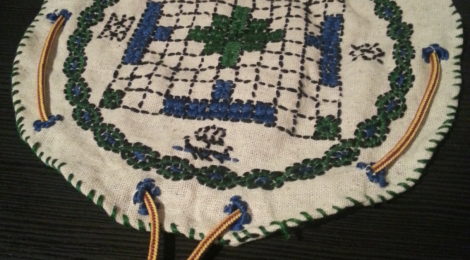
Tafl and Hedeby style pouch
Tafl or hnefatafl (literally “fist table”), is a Norse board game which spread to neighbouring lands during the viking age and was later supplanted by chess in the 12th century. The game was most probably derived from and even older Roman game, Ludus latrunculorum/Latrones (Brigands) which was played throughout the empire. A similar game, Tablut was played by the Sápmi people of Finland until the late 1700s, when it’s rules were written down by scientist Swedish scientist Carl Linnaeus in 1732.
There are multiple variations of the initial start position and of the grid size, but the board is quickly set up which was great for the travelling Norsemen to play on long voyages. The start position is rather odd as it is an uneven start, on player has a king surrounded by his warriors that seeks to escape to one of the four corners, while the other player has a numerically superior force that must capture the enemy king. The starting position for a game of Hnetatafl can be seen in the picture below, the green area in the center is for the king’s warriors with the distinctive king pawn in the center while the blue regions on the sides are for the opposing team.
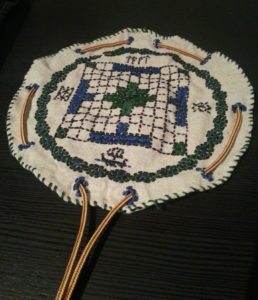
Game Layout and Starting Positions
The board is an 11 x 11 grid, in this case every square is 1 cm to a side, if I were to redo this I would probably go with 2 cm, it makes finding pawns that fit much easier. Once set, the attacker makes the first move, a player can only move 1 pawn per turn. All pawns can move any distance horizontally or vertically along the grid, but no pawn may jump over any other or land on its square.
There are 5 special square which only the king can occupy, those being the escape corners and the central square, as seen in the following picture. A pawn other than the king is captured and removed from the board when it’s caught between two enemy pawns in a single row or column, a marked empty square also counts as an enemy pawn. A row of pawns can be captured if they are pinned on all sides on the edge of the board, in a “shield wall” capture.
To capture the king he must be surrounded on all four sides by his attackers or three sides if he is against the board’s edge or the empty marked central square. If the king is captured or all of the defender’s pawn are immobilized the attacker wins and if the king escapes the defender wins. The defender can also win by immobilizing all of the attacker’s pawns or building a fort of pawns on the edge that cannot be captured but allows the king to move infinitely inside.
Pouches were easy to make bags for everything from coins to herbs and could be stashed away into one’s clothes or looped at one’s belt for easy access. Here a very simple Hedeby style pouch, like the one exposed at the National Museum of Denmark, is embroidered with the tafl game board, in this way the game pieces can be carried inside, ideal for the travelling vikings among us.
Firstly the grid for the game was laid out on a linen or cotton cloth.
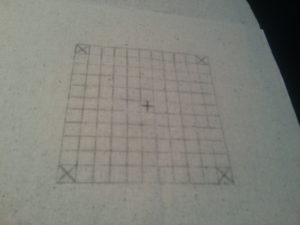
Tracing out the Tafl grid pattern on paper
The edges and the cross patterns for the marked squares are embroidered in black to stick out more readily on the cloth. A simple embroidery hoop, scissors, needle and thread are all the tools necessary for this little project.
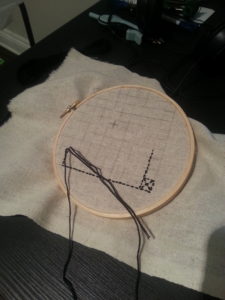
Starting the cross-stitch on the transferred pattern
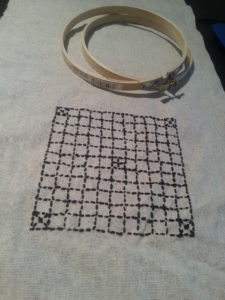
Finished game grid
Once the grid is laid out and clearly defined, decorations fitting of a viking can be added. People from all walks of life have always taken pride in their belongings, and a little fancy needle work could go a long way in making a bland checker board look halfway decent. Sketching out the design on paper and then tracing it with a black marker allowed the design to be seen through the cloth’s weave.
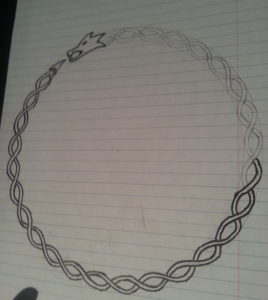
Highlighting Jörmungandr with a Sharpie
There with a pencil, the design was transferred to the cloth and the outside was embroidered with a black outline.
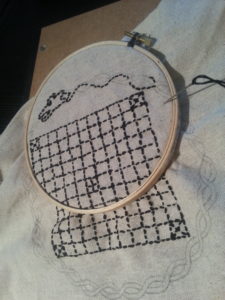
Stitching the outline of the monster
The serpent was then filled in with colour to give a more lively feel to this game.
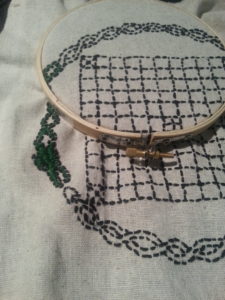
Filling out with colours
The starting positions were also defined and some runes and geometric patterns were added to fill in the space.
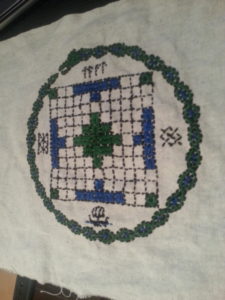
Fully coloured and decorated
The pouch was cut out as a simple circle and slots cut for a lace. The eyelets were then secured from ripping with stitched grommets. The edge was triple folded and sewn through to make a secure edge that wouldn’t fray.

Stitched grommets and triple folded edge
Once laced, the pouch is ready to carry some pawns.
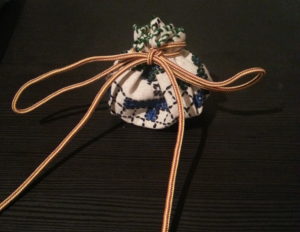
All packed up in its own bag
I’m still looking for the right pawns for this game board, and I may end up making my own, probably 3D printed for expediency. As mentioned, a larger grid would have made finding or making pawns easier.
